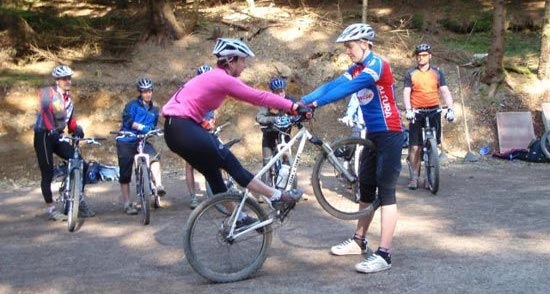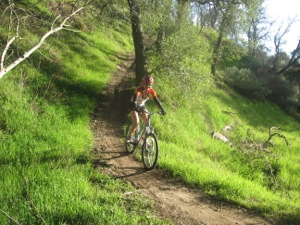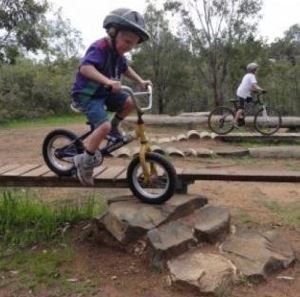Mountain bike riding is just one big journey of self-development. Once you find a trail you learn to ride it better. Once you learn a skill you learn to do it better and smoother - with most skills branching off into other skills. It's just a big spaghetti bowl of bikespoloration, and it rocks!
You've heard the awesome stories from your mates and decided to take it to the trails yourself. But what do you need to learn before even attempting to keep up with your riding pals? Hopefully they teach you the cool stuff, but you can rely on us to help you learn the very basics - the stuff you're too embarrassed to ask. The stuff you're magically expected to know already, even though your last sport may have been water polo.
Skills like these that can be practiced anywhere. Remember, it's all about timing when learning some of these skills, so be patient!
Before we start, here is what not to do: 5 common mistakes when starting out mountain biking
Lifting the Front Wheel

It might seem easy to do but there's always the chance to do it better. This skill is probably the easiest skill to learn, as well as being the best skill to develop further (along the lines of a manual or riding a drop-off). To lift the front wheel correctly it's a matter of transferring your body weight backwards at the same time as pulling back on the handlebars with your arms fully extended (not bent at the elbows). See it as the rear wheel being a pivot point, and you're trying to tip over the rear wheel and land on your back...
- Stand up
- Lean back hard, at exactly the same time as pulling back with extended arms
- Tilt your head back to enhance the 'pull back' effect and body weight transfer
This will allow you to pop your front wheel over any small to medium obstacle and then allow the back wheel to just roll over the obstacle. You can then perform this manoeuvre sitting down, which is handy when riding uphill.
Braking Safely

It's all fair and well that you're now flying down the trail at record speeds, but it might be time to learn how to slow down - properly. Brake application can become more advanced as your riding progresses, allowing you to intentionally slip and slide into really tight corners, or even just flick dirt at your riding pals. But the starting point is this:
- Try applying brakes evenly on the front and rear levers when you want to slow down a little.
- Apply more front brake than back brake when trying to slow down drastically - remain in a straight line when doing so!
- Apply more rear brake than front brake when trying to get your bike to turn sharper at a slower speed - especially on a 29er...
Always remain in control of your braking, and never grab the brakes in panic. This can result in a sudden slowing of the given wheel, and a subsequent crash as the wheel slides out from underneath you. Be calm and smooth when braking, and consciously be aware of what you're doing - it's a great skill to have.

TIP: Test this for yourself. While riding through a corner, notice the affect braking can have. Typically, braking in a corner transfers forces forward and compresses the suspension resulting in more "lean". Let go of the brakes and the bike will naturally right itself. This is one reason many mountain bikers hit the deck or go over the bars while cornering: it's the result of being too hard on the brakes mid corner. For beginners it is best to regulate your speed with the brakes before the corner is reached and then only lightly feathering once committed to the turn.
Changing Gears
Changing gears seems pretty self-explanatory. But when is the best time to change gears? On a mountain bike, gear selection is dictated by the terrain you're riding, so you really need to read the trail and look ahead to predict your need to change gears! A good tip is to scan the trail much like you do when you drive a car. Look far ahead and then look immediately in front. Then look far ahead, and then directly in front.
This technique allows you to predict your need to change gears, as well as spotting obstacles or smoother riding lines. Eventually this will become second nature, but until then, make a real effort to learn this method of scanning. It will pay off later on!
As far as the gear changing actually goes, always change gears as you need. Don't slam through four gears because there's a hill down the trail. Wait til you get to the hill, and change one or two gears as needed. This helps you maintain momentum and avoids unwanted loss of speed and traction!

TIP: Check out this article for some more detail on riding specific conditions: "Mountain bike skills: Choosing a line, handling gravel and drop-offs"
Riding over small obstacles
Refer back to skill number 1: "Lifting the Front Wheel" - This is what is needed to negotiate a small obstacle. A small obstacle generally doesn't require any special skill other than momentum and timing. As you approach the object on the trail, stand up and get into your attack position (even body weight, knees bent). Depending on your speed, begin lifting the front wheel when you are about 20cm from the object. The faster you are riding, the more this distance increases and timing becomes even more crucial! Once you have lifted the front wheel over, bend your knees to absorb the impact of the back wheel rolling over the same obstacle.
Riding down slopes
Another skill that seems pretty obvious, or is it? When you ride down a slope as a beginner rider you might think that you just roll down, and away you go. If only it were that easy...
When you approach a steep slope, it's always best to ride down it straight, or square on. This means you are not riding down the slope diagonally and you're increasing your traction and ability to 'ride the brakes' down the steep slope. As you approach the very top of the slope you should be at a slow pace already:
- Slow down, and roll over the top of the slope
- Apply more rear brake than front brake, but avoid skidding or sliding down the hill
- Lean back!! This prevents you from going over the handlebars
- As you reach the bottom of the slope, bend your elbows and knees as you enter flat ground
Hey presto! This technique is more common sense than anything, but it's the basis of learning just how steep the trail can be without you riding out of control. Learn to control your speed from the start rather than trying to regain control of your speed...
Now it's time to get out there, put all of this into practice, and learn the basics; it's the key to advancing to more technical skills later on. If you're riding with some friends you might learn by watching them, or even asking them to take the time and teach you. It'll open a whole new world of bikesploration for you!



